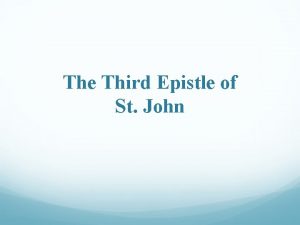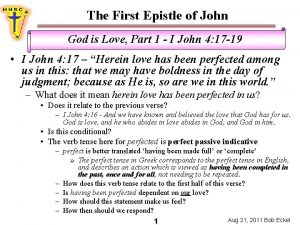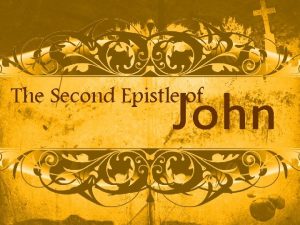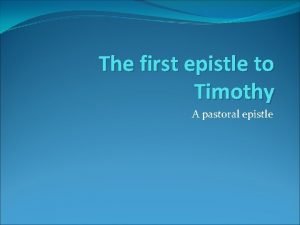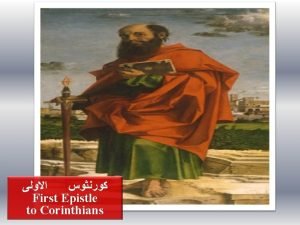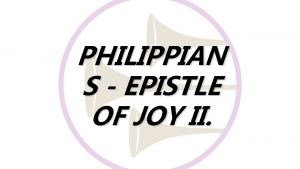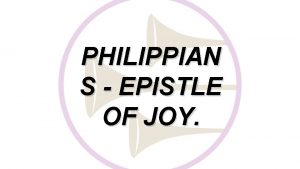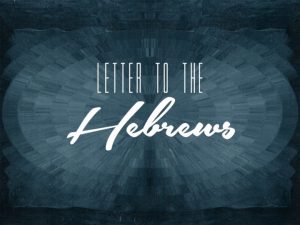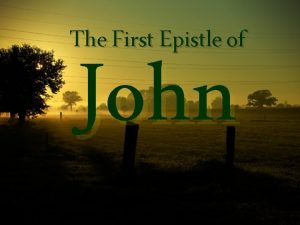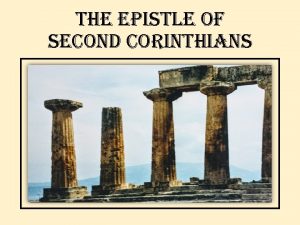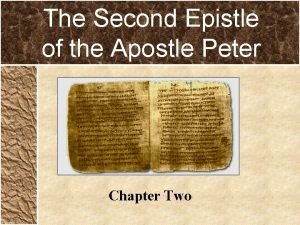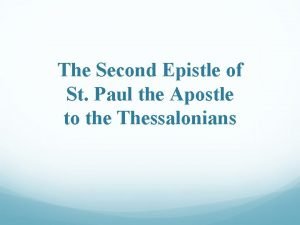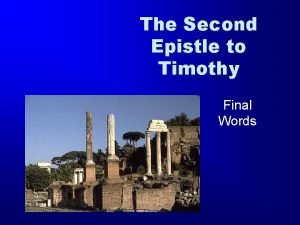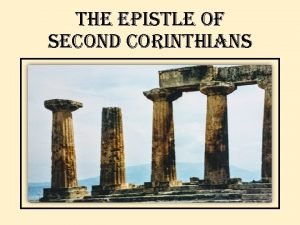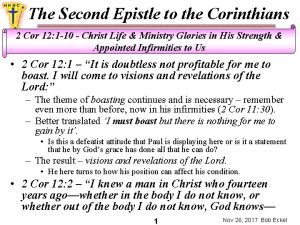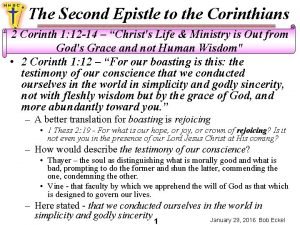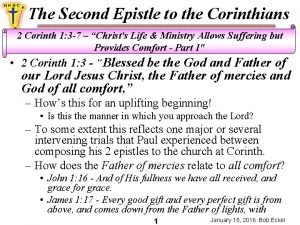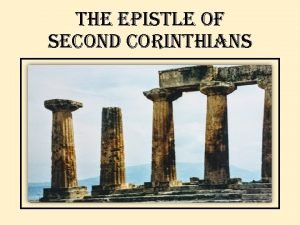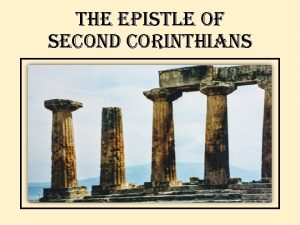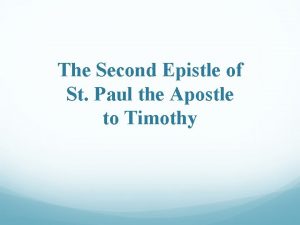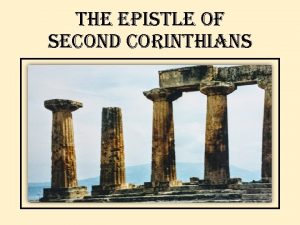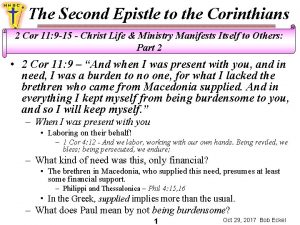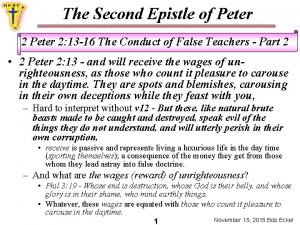The Second Epistle of John This epistle is






















- Slides: 22


The Second Epistle of John: • This epistle is very similar to the third epistle of John. • They were personal short letters to friends, which were preserved for the church. • Undoubtedly written on the standard papyrus sheet of that day, each of them would have been one page in length.

The Second Epistle of John: • Both of these short letters were written about the same time and almost certainly were written in Ephesus. • The purpose of this second epistle was to worn against heresy and having fellowship with false teachers. • At this particular time in the history of the church, there were many itinerant preachers.

The Second Epistle of John: • These men traveled from church to church living at the expense of the local congregations. • Many times they were false teachers who sought to undermine the foundation doctrines. • It was against these false teachers that John warned.

The Elder: • The author of this epistle called himself "the elder. " • Certainly he was none other the than Apostle John who wrote the gospel, the epistles of John and the book of Revelation. • Elders were church officials who were ordained to minister within a local congregation.

The Elder: • The term is not used with this meaning here. • The word does not refer to an official but rather to the meaning of the term in the natural sense. • The word "elder" here could be translated "the ancient" or "the aged. "

The Elder: • It is from his position of age and experience that John wrote this epistle. • Here we have John, an aged saint, one of the last of the first century Christians. • He was one of the last disciples of Christ in the flesh and therein lay his authority to speak.

The Elect Lady: • John addressed this letter to the "elect lady and her children. " • Bible scholars have never been able to settle regarding the identity of this elect lady. • There are two interpretations, either one of which may be correct. • Both of these are given here although the writer believes that the second one is probably correct.

The Elect Lady: • 1. A Local Church near Ephesus: • It is concluded that the elect lady is a church for she is loved by all that have known the truth. • This would hardly be true if she were an individual. • Also she is addressed in this epistle in the plural.

The Elect Lady: • If she is a church, then her children would be the Christians who worship the in local assembly. • Her elect sister would be another local assembly, possibly in Ephesus, where John worshipped. • It must be admitted that this interpretation could be correct for the church is feminine in gender and is the bride of Christ.

The Elect Lady: • 2. An Unknown Lady: • The simplicity of the epistle would cause a person to believe that it was addressed to an individual. • The Greek here used for lady is "kuria. " • It was not unknown for this to be a proper name. • It is probable that the epistle was written to the elect Kuria.

The Elect Lady: • She would have been a prominent lady, residing near Ephesus, who was well known in the community. • Very likely her home was the meeting place of the local church. • She had a sister who was now deceased but whose children attended John's congregation.

The Elect Lady: • The elect lady's children had apparently visited their cousins and John had become acquainted with them. • Having become acquainted with them, John wrote their mother this letter.

The Salutation: • The wording of the salutation is interesting. • In other epistles the salutations are given in the form of a prayer. • Here the salutation is a statement: "Grace, mercy and peace will be with us. " • John does not pray that they might receive these gifts of the grace of God, he assures them that THEY WILL receive them.

Love and Truth: • "Grace be with you, mercy, and peace, from God the Father, and from the Lord Jesus Christ, the Son of the Father, in truth and love" (II John 3). • In this epistle love and truth are closely connected. • It is in the truth that the elder loves the elect lady and it is because of the truth that he writes this epistle.

Love and Truth: • • • Truth tells us how we should love. "Agape" is the word for Christian love. This love will always seek the highest good of others. It is significant that John writes in love to warn them. The word "truth" is used five times in the first four verses.

Warning against Threatening Peril: • (II John 4 -9). • John reminded the lady of the commandment to love one another. • In verse 5 the commandment is to love while in verse 6 love is obeying His commands. • Love is not just a soft sentimental emotion without direction. • Rather love is revealed in a healthy principle, which will cause us to do the right thing.

Warning against Threatening Peril: • John now warned the lady against a spreading heresy, which was a denial of the incarnation. • He exhorted her to self-examination in verse 8. • "Look to yourselves, that we lose not those things which we have wrought. . . " • He then exhorted her to examine others on the basis of their abiding in the truth.

Warning against Threatening Peril: • The doctrine of Christ is the truth of the incarnation. • Those who deny this truth have not God; those who continue in this truth have both the Father and the Son. • John called those who denied this truth, deceivers. • Such a man was both a deceiver and an antichrist.

No Compromise: • • (II John 10 -13). There must be no compromise with false teaching. These false teachers were to be given no hospitality. A refusal of hospitality would help to stop the spread of the heresy.

No Compromise: • Not only were they not to be invited into the home, but they were not to be given a greeting on the street. • Giving a man God speed is to encourage him and to fellowship him in his false teachings. • It would be a false love to invite such a one into our home.

No Compromise: • For truth's sake, they are to be refused admission. • This admonition given to the elect lady is one the church should remember in these lazy days of widespread heresy.
 The third epistle of st. john is addressed to________.
The third epistle of st. john is addressed to________. Epistle to the god of love
Epistle to the god of love Catholic epistle
Catholic epistle 27 miles per gallon into kilometers per liter
27 miles per gallon into kilometers per liter Hát kết hợp bộ gõ cơ thể
Hát kết hợp bộ gõ cơ thể Lp html
Lp html Bổ thể
Bổ thể Tỉ lệ cơ thể trẻ em
Tỉ lệ cơ thể trẻ em Chó sói
Chó sói Tư thế worms-breton
Tư thế worms-breton Chúa yêu trần thế alleluia
Chúa yêu trần thế alleluia Môn thể thao bắt đầu bằng chữ đua
Môn thể thao bắt đầu bằng chữ đua Thế nào là hệ số cao nhất
Thế nào là hệ số cao nhất Các châu lục và đại dương trên thế giới
Các châu lục và đại dương trên thế giới Công thức tiính động năng
Công thức tiính động năng Trời xanh đây là của chúng ta thể thơ
Trời xanh đây là của chúng ta thể thơ Cách giải mật thư tọa độ
Cách giải mật thư tọa độ Phép trừ bù
Phép trừ bù Phản ứng thế ankan
Phản ứng thế ankan Các châu lục và đại dương trên thế giới
Các châu lục và đại dương trên thế giới Thể thơ truyền thống
Thể thơ truyền thống Quá trình desamine hóa có thể tạo ra
Quá trình desamine hóa có thể tạo ra Một số thể thơ truyền thống
Một số thể thơ truyền thống
